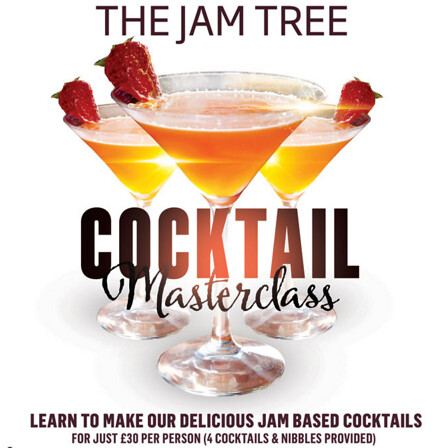Maddie Salters attends a gin masterclass at The Jam Tree in Clapham.
If your prohibition-era proclivities have ever led you to yearn for a night in a private bar cleverly disguised by a bookshelf, you need look no further than Clapham. A trip on the Northern Line and a jaunt down a high street cluttered with trendy shops will bring you to The Jam Tree, where jam-based cocktails, bright decor, and a love for late-night partying are paramount.
I visited for the Bombay Sapphire Masterclass – which I very nearly couldn’t find. Having been directed to go to the room ‘in the back’, it took a bit of finagling before I realized with a jolt and thrill of excitement that the wall of bookshelves; handsomely filled in with starchy, hard-backed classics; was, in fact, the door. Tilting a shelf open, I slipped inside to find an expansive setting of leather sofas alongside a bar, and in the middle of it all– a Bombay Gin sommelier, ready to lead me on a journey through the tasting notes of their carefully-guarded recipes.
Bombay has been gin-makers for over 250 years. I learned, through the course of the evening, about gin’s checkered Maritime past as the tonic (no pun!) of choice for curing sailors of malaria. While gin used to be only palatable through adding tonic water to it, these days (the sommelier reminds me) “You’re drinking gin and tonic– not tonic and gin.”
In fact, to understand the complex series of botanicals in each of Bombay’s three gins– Bombay, Bombay Sapphire, and their newly-released Star of Bombay– I decided to forgo tonic water altogether. The verdict?
Of the three, the Bombay Sapphire still impressed me the most. It’s a bit more intense than the Bombay, with more complex aromatics. Its botanicals are sharply profiled, but combine well into a smooth drink, with notes of lavender and violet standing out, contrasted by a woody soft note of pine. Made using eight main botanicals, each individually imported from points around the globe, I was thrilled when the physical ingredients themselves were brought out for me to touch, feel, smell, and taste alongside the gin. I especially appreciated getting to taste the Japanese tail peppercorn, with its mauled texture and bold flavour. After mulling it around in my mouth for a while before my next sip of gin, I could finaly identify it within the drink. The pepper resonates in the gin, by cooling the citrus notes of lemon peel and bergamot, and binding them to the sweet angelica and licorice roots. The Sapphire is a truly layered drink.
That said, while I may have a bias towards the Sapphire, I can see occasion for choosing the Star of Bombay over it. With a higher alcohol content (47%, versus 40% in the Sapphire), and a heavier, sharper, and spicier taste, here is a lovely gin for combining in cocktails. The flavour won’t be lost, as the doubling of botanicals (including extra grains of paradise and juniper, along with muskier flowers) means its profile comes across in a bold burst of natural citrus that rises above any mixers.
I put my theory to the test, to great success:
When the tasting was over, I tried my hand at making a cocktail. I decided on a fixing up a Bombay Sour, using a double shot of the Star of Bombay. Chambord, egg white, orange bitters, and fresh lemon juice were shaken and served over ice, garnished with raspberries. The result? A night-out cocktail that would make the Appletini greener with envy and the Cosmo seem less cosmopolitan.
It’s safe to say that the G&T, a staple drink of the UK, will keep on re-inventing and innovating itself – a goal that’s always been at the heart of Bombay’s botanical experiments.
The Jam Tree is located at 13-19 Old Town, SW4 0JT. Find out more at thejamtree.com.






















